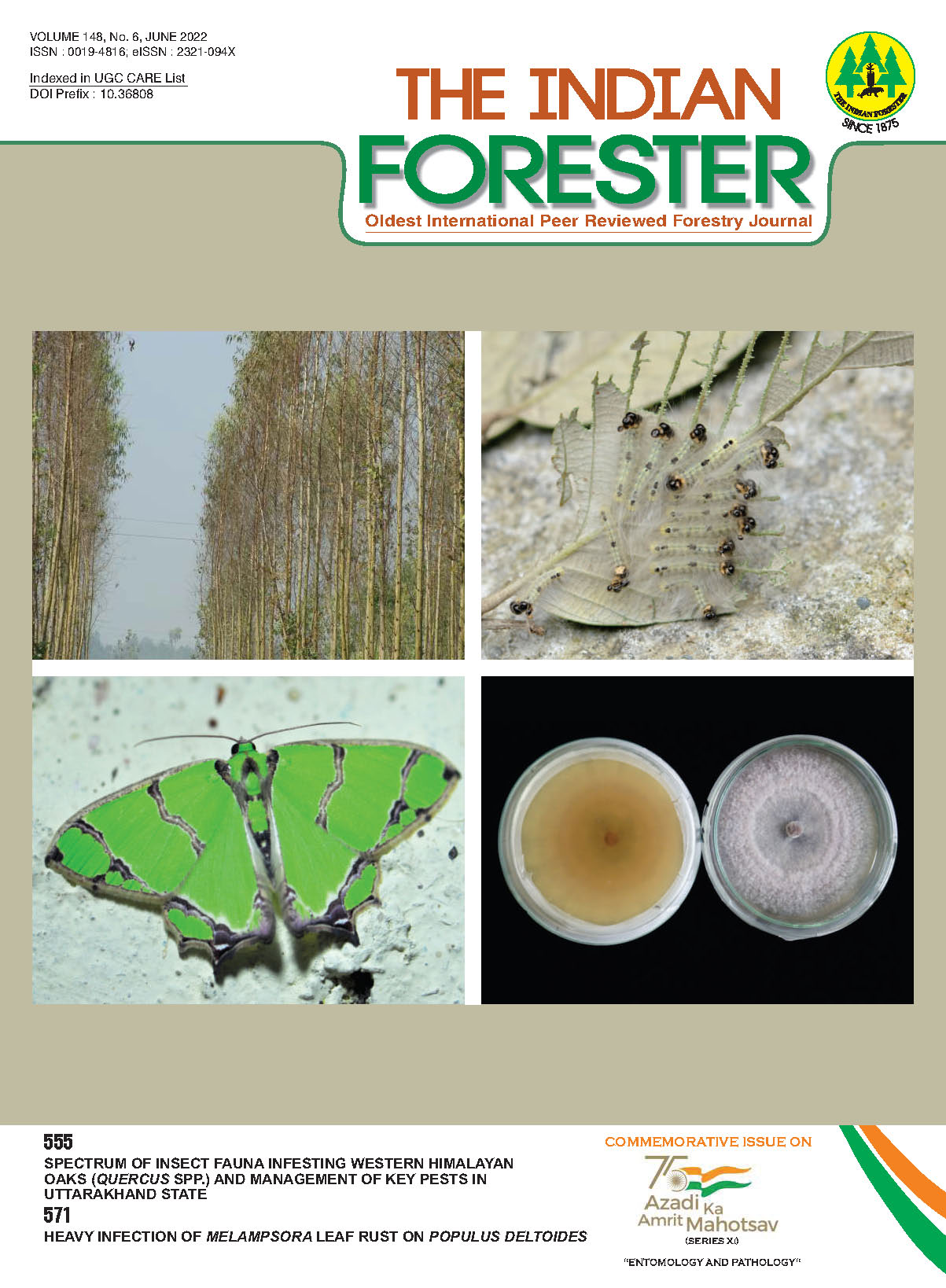Field evaluation of Populus deltoides clones for growth traits and tolerance to leaf spots
DOI:
https://doi.org/10.36808/if/2022/v148i6/158190Keywords:
poplar, variation, volume, foliar diseases, agroforestryAbstract
The study was conducted to evaluate the growth characters of the 16 clones of Populus deltoides under field conditions at the Main Experimental Area, Department of Forestry and Natural Resources, Punjab Agricultural University, Ludhiana following Randomised Complete Block Design with four replication and plot size of four trees. Significant variation was noticed among the clones for tree height, diameter and wood volume. Clones L-48/89, 9607, L-47/88, 9607 and 6503 Â were observed to be most promising for wood productivity. The poplar clones were found susceptible to leaf spots caused by Cercospora populina, Alternaria alternate, Drechslera sp. and Rhizoctonia sp. Clone L-48/89 with least leaf spots severity of 6.9 per cent was categorized as moderately resistant along with clone L-47/88, 9607 and T-50. Moderate susceptibility response against leaf spots was observed in clone T-59, G-48 and 5503. None of the clones exhibited resistant reaction to leaf spots.References
Anon. (2012). Poplar cultivation. A booklet by Punjab Agricultural University, Ludhiana.
Baranwal V.K., Mikkilineni V., Zehr U.B., Tyagi A.K. and Kapoor S. (2012). Heterosis: emerging ideas about hybrid vigour. J Exp Bot., 63: 6309–6314.
Chakraborty S., Luck J., Hollaway G., Freeman A., Nortan R., Garrett K.A., Percy K., Hopkins A., Davis C. and Karnosky D.F. (2008). Impacts of global change on diseases of agricultural crops and forest trees. Agricultural, Veterinary Science, Nutrition and Natural Resources, 3: 54.
Dhillon G.P.S., Sandhu J.S. and Singh P. (2020). Variation among Poplar (Populus deltoides Bartr.) clones for growth, wood traits and tolerance to leaf spot diseases. Curr. Agri. Res. J., 8(2): 128-136. http://dx.doi.org/10.12944/ CARJ.8.2.08.
Dhillon G.P.S., Singh A., Sidhu D.S. and Brar H.S. (2013). Variation among poplar clones for growth and crown traits under field conditions at two sites of North-Western India. J. For. Res., 24: 61-67.
Dhillon G.P.S., Singh A., Singh P. and Sidhu D.S. (2010) Field evaluation of Populus deltoides Bartr. Ex Marsh. at two sites in Indo-Gangetic plains of India. Silvae Genet., 59: 1-7.
Frey P., Gérard P., Feau N., Husson C. and Pinon J. (2005). Variability and population biology of Melampsora rusts on poplars. In: Rust Diseases of Willow and Poplar. Pei M H and McCracken A R, eds. CABI, Wallingford, Oxfordshire. pp. 63-72.
Garcia-Guzman G., Trejo I., Acosta-Calixto I. and SanchezCoronado M.E. (2016). Environmental factors associated with disease incidence in plant species from a Mexican seasonal tropical dry forest. Journal of the Torrey Botanical Society, 143(3): 254-264.
Gupta A.K., Khera H.S. and Singh S. (2001). Incidence of leaf spots of poplar in three agro-climatic zones of Punjab. Plant Disease Research, 16: 134-136.
Gupta A.K., Singh D. and Singh A.K. (2014). Effectivity of different fungicides against foliar leaf spot pathogens of poplar under in-vitro and in-vivo conditions. Hort. Flora Res. Spectrum, 3(1): 40-44.
Harniss R.O. and Nelson D.L. (1984). A Severe Epidemic of Marssonina Leaf Blight on Quaking Aspen in Northern Utah. Research note INT-399, USDA, Intermountain Forest and Range Experiment Station Ogden, UT 84401. Available at https://www.fs.fed.us/rm/pubs_ int/int_rn339.pdf Isik F. and Toplu F. (2003). Variation in juvenile traits of natural black poplar (Populus nigra L.) clones in Turkey. New For., 27: 175–187.
Kumar R., Kumari B., Bhardwaj K.K., Kumar A. and Kumar T. (2017). Study on Growth and Phenotypic Characters of Different Clones of Poplar (Populus deltoides Marsh.) in Nursery. Int. J. Curr. Microbiol. App. Sci., 6(12): 1840-1848.
Luna R.K., Thakur N.S. and Kumar V. (2011). Growth performance of twelve new clones of poplar In Punjab, Ind J. Ecol., 38: 107-109.
Mohan V. and Manokaran P. (2013). Assessment of disease problems in different clonal plantations of Eucalyptus spp. in South India. J. Acad. Indus. Res., 1(9): 514-24.
Rattan G.S., Singh P. and Chowdary (2009). Investigations on the assessment of leaf area damage by the foliar pathogens and their management in Poplar. In Singh R.S., Pal M. and
Sharma R.C. (eds) Forest Insect Pest and Disease Management in Northwest Himalayas. pp 153-70. Himalayan Forest Research Institute, Shimla, India.
Singh Y.P., Uniyal K., Bagwari A., Kavita, Barthwal S., Dhiman R.C. and Gandhi J.N. (2012).Status of poplar disease in India. ENVIS Forestry Bulletin, 12(1): 84-99.
Stanton B.J., Serapiglia M.J. and Smart L.B. (2014). Poplars and willows: trees for society and the environment In: Isebrands JG, Richardson J (eds) The domestication and conservation of Populus and Salix genetic resources. CABI international, Wallingford, pp 124–199.
Downloads
Downloads
Published
How to Cite
Issue
Section
License
Unless otherwise stated, copyright or similar rights in all materials presented on the site, including graphical images, are owned by Indian Forester.





